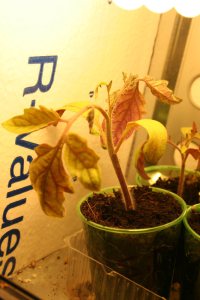Average last frost dates are only right half of the time
16.1 years ago indoor growbox, indoor seed starting, spring, tomato
Our last frost date in my area should have been March 24th but given the frosty mornings this past week and the fact we had snow coming down most of today it looks like this year our last frost date will fall on the other side of the bell curve. Unfortunately, I was optimistic with some of the great weather we were having earlier and planted my tomato seeds for a much earlier move outside. The poor tomatoes are still growing in my PC grow box but starting to not look so good. As you can see from the picture below my tomato plants are in some dire need of some non-artificial light. I am afraid I might end up buying my tomato plants at my local nursery (yet again) this year. Vegetable gardening is definitely one of those hobbies which it does not pay to be a too optimistic.

Tags: cheap, garden seeds, growbox, outdoor plants, tomato plants, vegetables
Planting our butterfly garden
16.1 years ago butterfly garden, indoor seed starting
Yesterday with the weather almost getting to 60 seemed like a good day to try sow some of our vegetable seeds outside for our butterfly garden. I tried to make things organized by grouping the Black-eyed Susan, purple coneflowers, zinnias, and nasturtiums, but my daughter decided to distribute the seeds a little more random. I am sure the butterflies won’t mind and guess it should look a little closer to how nature would do it.
I have learned from my years of gardening I normally am too optimistic about when seeds can be planted outside so as a backup plan we also planted some of the same seeds indoors which are currently trying to push their way closer to the PC grow box.
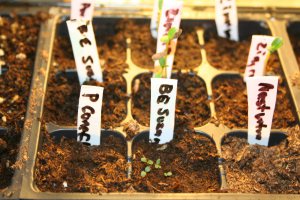
Read Other Butterfly Garden Posts
Tags: butterfly garden, cheap, garden seeds, growbox, outdoor plants, vegetables
Spring Rainbow
16.1 years ago spring
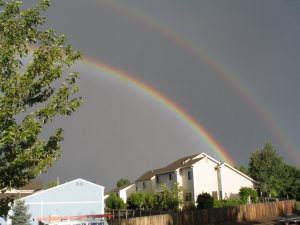
Happy first day of spring, well this picture was not taken this spring but still a good reminder of days to come.
Tags: cheap, vegetables
Speed Composting
16.1 years ago alfalfa pellets, compost
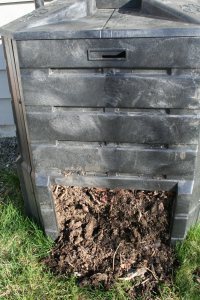
Unfortunately I have a small yard so my space to compost is limited so my goal is to make sure the most use out of the limited space I have. I am also impatient and don’t want to wait a couple years to finally get some compost. Here are some of my suggestions on how to be a speed composter.
Make stuff smaller: The small the you break up the material the faster it will decompose, instead of putting in those leaves freshly raked run over them with your lawn mower or take a few passes with your weed whacker. If you have kitchen waste chop or blend them to help the bacteria out.
Be selective about what you add: The basic idea if the material was alive at some point in its life it will decompose. That gives you a lot to choose from but if you want to speed compost you need to be a little selective about what you add. Lettuce, fruits, most vegetables (carrots take awhile unless you shred), leaves, grass clippings, shredded newspaper will decompose quickly. Items like small branches, vines though will compost over time I would recommend adding these to your yard waste bin.
Create a good environment: You want to create a healthy environment for microorganisms to be happy and reproduce. To thrive they need moisture and air so if you bin it should have the consistency of a wrung out sponge. If you find your bin is lacking moisture just add some while you mix it. This is definitely one of those situations where more is not better too much moisture and you will suffocate the microorganisms due to lack of oxygen. If you find your bin is too wet (usually will start to smell) simply mix (aerate) with an compost mixer or a pitch fork. If it is more of a muddy mess spread it out for a couple days and you should be back to having a microbial breading ground again.
Provide a good diet You want to provide your bin with a proper balance of nitrogen and carbon. The documented best ration is 30 to 1 (carbon to nitrogen) but I wouldn’t get too concerned about exact numbers just keep in mind a compost with just leaves or grass clippings will not be the most efficient way to get some compost into your garden. During certain parts of the season you will find that some nitrogen or carbon materials are harder to come by. For example in the fall you will have all kinds of leaves but your lawn and garden will be baron with greens, while being just the opposite in the summer where you will have a lot of nitrogen rich materials and no carbon. This is an opportunity to supplements your compost by adding nitrogen (alfalfa pellets, blood meal) during the fall/winter and adding carbon (newspaper, sawdust) during the spring/summer time.
Follow these tips and you should have great compost at record speeds.
Tags: alfalfa pellets, cheap, compost, vegetables
Planning a butterfly garden
16.1 years ago butterfly garden, kids
I got the word this weekend we had enough vegetables and not enough flowers in our garden beds so got the idea to start a butterfly garden. Upon telling my 6 year old daughter she got very excited and started talking how we can charge admission for people to see our butterfly garden.
There are two ways to get butterflies in your gardens, provide nectar to eat and/or give them a great environment to lay their eggs. If you remember your grade school science classes those eggs turn into caterpillars which depending on what else you have in your vegetable garden this might not be exactly the pest you want to encourage to inhabit your garden. If that is your situation I would recommend only planting the nectar attracters. After carefully investigating what caterpillars eat by reading The Very Hungry Caterpillar from cover to cover I decided my risk should be minimal if we have our butterfly garden on the other side of our yard away from our strawberries.
To attempt to get the butterflies to lay eggs, we bought Snapdragons and Daisies. To provide butterflies with tasty nectar we picked out Black-eyed Susan, purple coneflowers, zinnias, and nasturtiums, Lavender, Daisies (as well), and Mint. We are also planning on creating a butterfly feeder by taking a small jar and drilling a hole in the top. Put some cotton snuggly in the hole and fill with solution of 1 part sugar to 9 parts water and cheap butterfly (or hummingbird) feeder is ready for visitors.
Will keep posted with progress on the butterfly garden and I anticipate the butterfly feeder will have plenty of “decorating” involved. If you want something that might look a little more attractive in your garden you might want to take a look at the commercial butterfly feeders.
Read Other Butterfly Garden Posts
Tags: butterfly garden, cheap, outdoor plants, strawberry plants, vegetables
Tomato seedlings in the PC Grow Box
16.1 years ago indoor growbox, tomato
The strawberry plant got too big for the PC grow box so I planted it back outside where it is doing great. Now my tomato plants have more room to grow and have to compete less for the limited light. I have been impressed with my tomato plants in the grow box. I think this is the first year I have grown tomatoes that were not all white and leggy. One the cherry tomato (Sweetie) plants already grew enough my daughter and I had to transplant it to a large pot we will sit on our front porch that has good southern exposure.
The rest of the tomato plants are growing a little slower but should be perfect to move outside after our last frost which in my area is March 22nd.
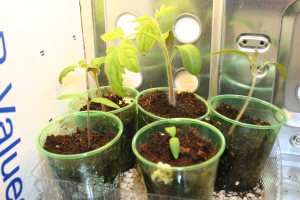
Tags: cheap, garden seeds, growbox, outdoor plants, strawberry plants, tomato plants, vegetables
